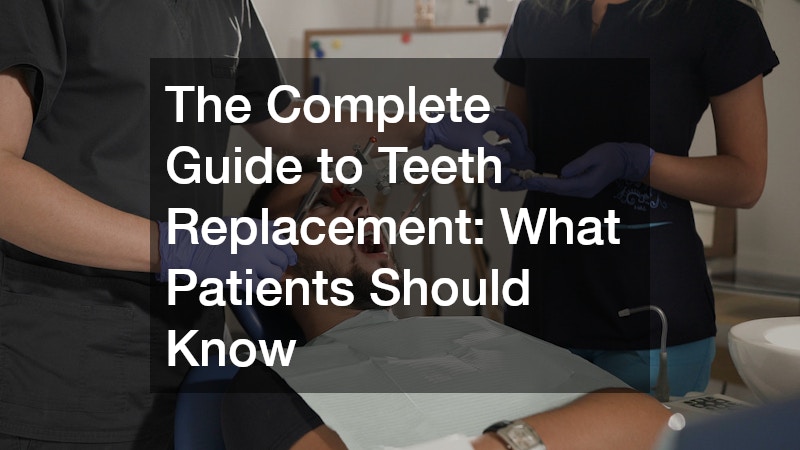Disclaimer: This website provides health information for educational purposes only and is not a substitute for professional medical advice, diagnosis, or treatment. Always seek the guidance of a qualified healthcare provider with any questions you may have.
In the realm of dental health, teeth replacement has emerged as a crucial topic for many seeking to restore their smile and functionality. With various options available and numerous questions surrounding the process, it can be overwhelming for patients to determine the best course of action.
What Are the Different Types of Teeth Replacement Options?
Dental Implants
Dental implants are widely regarded as one of the most effective teeth replacement options available today. The procedure involves the surgical placement of a titanium post into the jawbone, which acts as an artificial tooth root.
Over time, this post fuses with the bone, providing a stable foundation for the attachment of a crown or bridge. The primary benefit of dental implants is their durability and longevity, often lasting for decades with proper care. Moreover, they offer a natural look and feel, enhancing not only the patient’s smile but also their confidence.
The process of getting dental implants typically requires several appointments. Initially, a thorough examination and consultation are conducted to assess the patient’s oral health and jawbone condition. If deemed suitable for implants, the post is surgically implanted, followed by a healing period of several months to allow osseointegration. Once the post is securely anchored, an abutment is attached, and the final crown or prosthetic is placed. This procedure can vary in complexity depending on individual circumstances, but the results often speak for themselves in terms of improved aesthetics and function.
Dental Bridges
Dental bridges are another prevalent choice for replacing missing teeth, especially when the gap is surrounded by healthy teeth. A bridge involves creating a crown for the tooth on either side of the gap and placing a false tooth, known as a pontic, in between. This option is less invasive than implants, as it does not require surgery on the jawbone. Instead, dental bridges rely on the support of surrounding teeth, making the procedure quicker and less intensive. They are particularly suitable for individuals looking to replace one or a few adjacent teeth efficiently.
The bridge fitting process typically involves preparing the abutment teeth by reshaping them to accommodate the crowns. The dental professional will take detailed impressions of the teeth, which are used to create a precisely fitting bridge. This ensures that the bridge not only restores functionality but also blends seamlessly with the patient’s natural teeth. Once ready, the bridge is cemented into place, providing a sturdy and aesthetically pleasing solution to missing teeth.
Partial and Full Dentures
Partial and full dentures are traditional solutions for those dealing with extensive tooth loss. Partial dentures are designed for individuals missing several teeth, while full dentures replace an entire arch of teeth, either upper, lower, or both. These removable appliances are custom-made to fit comfortably and securely in the mouth, restoring the ability to speak and eat with confidence. Modern dentures are crafted from high-quality materials that mimic natural teeth, offering a practical and affordable alternative for many patients.
The process of obtaining dentures begins with a thorough evaluation and impression-taking to ensure a tailored fit. Patients may require several fittings to achieve optimal comfort and function. Partial dentures typically attach using metal clasps that hook onto the remaining natural teeth, whereas full dentures rely on suction and, occasionally, denture adhesives to remain in place. This variety in design allows dental professionals to recommend the most suitable option based on the patient’s unique oral condition.
Long-term care for dentures involves regular cleaning and maintenance to prevent issues such as gum irritation or infections. They must be removed and cleaned daily, and any changes in fit or discomfort should be addressed by a dental professional promptly. Although dentures may not offer the same level of stability and natural feel as implants or bridges, they remain a valuable choice for individuals seeking a non-surgical and flexible teeth replacement solution. Advances in denture technology continue to improve comfort and appearance, making them a viable option for many seeking to restore their smiles.
What Is the Recovery Process Like After Teeth Replacement?
Initial Healing and Care
The recovery process following teeth replacement procedures varies depending on the method chosen. For dental implants, the initial healing phase is critical as it involves osseointegration, where the titanium post integrates with the jawbone. This period can last several weeks to a few months, during which patients are advised to follow specific care instructions to avoid complications. Eating soft foods, maintaining excellent oral hygiene, and attending follow-up appointments are essential for promoting successful healing and ensuring the stability of the implant.
Dental bridges and dentures typically require a shorter recovery time, yet patients must adapt to the new appliances. Minor discomfort or adjustments may be necessary as the mouth accommodates the change. Dentists often provide guidance on dealing with any temporary issues, such as speech difficulties or sensitivity, and offer tips for adapting to daily functions like chewing and speaking. Transitioning to these replacement options involves an adjustment period but usually results in improved comfort and function.
Teeth replacement is a significant step for many individuals aiming to improve both their appearance and oral health. Understanding the various options, costs, and recovery processes can empower patients to make informed decisions that align with their needs and lifestyle. By consulting with dental professionals and considering all available information, patients can enjoy the benefits of teeth replacement with confidence.
